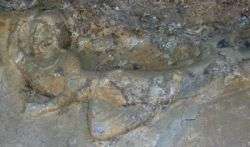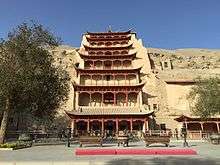Hinduism in China
Hinduism (specifically the sect of Shaivism) is currently practiced by a minority of residents of China. The religion itself has a very limited presence in modern mainland China, but archaeological evidence suggests a significant presence of Hinduism in different provinces of medieval China.[1] Hindu influences were also absorbed in the country through the spread of Buddhism over its history.[2] Practices originating in the Vedic tradition of ancient India such as yoga and meditation are also popular in China. Some indigenous people in China, pray to Hindu gods such as Shiva, Vishnu, Ganesha and Kali.

Hindu communities, particularly through Tamil merchant guilds of Ayyavole and Manigramam once thrived in medieval south China.[3][4] Evidence of Tamil siva motifs and temples, such as in the Kaiyuan temple, continue to be discovered in Quanzhou, Fujian, a province of southeast China.[5] A small community of Tamil immigrant workers currently exists in Hong Kong.
History

Arthur Waley (1889-1996) while translating Tao Te Ching (The Way and Its Power) commented:[6]
"I see no reason to doubt, that the 'holy mountain-men' (sheng-hsien) described by Lieh Tzu are Indian Rishi; and when we read in Chuang Tzu of certain Taoists who practiced movements very similar to the asanas of Hindu yoga, it is at least a possibility that some knowledge of the yoga technique which these Rishi used had also drifted into China."
Also, Arnold Hermann Ludwig Heeren (1760-1842) observes that:[7]
"the name China is of Hindu origin and came to us from India."
Some examples of influence by Hinduism on ancient Chinese religion included the belief of "six schools" or "six doctrines" as well as use of Yoga, stupas (later became pagoda in East Asia). However, in China, Hinduism has never gained much popularity, unlike the beliefs of Buddhism and Confucianism. There were exceptions, such as in parts of Tibet.[8]
There was a small Hindu community in China, mostly situated in southeastern China. A late thirteenth-century bilingual Tamil and Chinese-language inscription has been found associated with the remains of a Siva temple of Quanzhou. This was one of possibly two south Indian-style Hindu temples (115) that must have been built in the southeastern sector of the old port, where the foreign traders' enclave was formerly located.[9]
The Four Heavenly Kings originated from the Lokapālas. Hanuman is believed by some scholars to be a source for the Chinese mythological character Sun Wukong.
The Yaksha (Chinese: 夜叉) originally from Hindu history, are a class of nature ghosts or demons. Belief in the Yaksha made its way to China through the Lotus Sutra, which was originally translated into Chinese by Dharmaraksa around 290 CE, before being superseded by a translation in seven fascicles by Kumārajīva in 406 CE.
Many legends and stories in Chinese folk religion, such as Nezha, have been traced to Hindu mythology,[10] such as through the 10th century translations of Tianxizai.[11] During this influence and synthesis of ideas, some terms were mapped into pre-existing concepts - raksasas as luocha, others terms were introduced - pisacas in Hinduism as pishezuo in Chinese.
Regions of influence
Ancient Chinese records as well as modern archaeological studies prove the presence of Hinduism in several regions of China:
- Ports of China in Guangdong and Quanzhou provinces, mainly by Tamil Hindu traders who had been welcomed by Chinese and who had established residencies (diaspora communities) and built Hindu temples while they facilitated and served the needs of Sino-Indian trade in a wide range of goods.[1][13]
- Kamrup route (Assam) through Myanmar into south Chinese province of Yunnan as well as other southwestern regions of modern China. This is attested by the discovery of linga and yoni (symbols associated with Shiva) in Jianchuan caves (Shizhongshan) and other Hindu motifs found during excavation of Dali temple in Yunnan.[1]
- Tsung-Ling route (now through Kashmir) was the route that helped monks and travelers from China bring Buddhism into China; along with Buddhist texts, many ancient Hindu texts and ideas were also carried into China. The archaeological evidence of Hinduism's presence in ancient China comes from Lop Nur and Kizil Caves in Xinjiang province, where carvings of deity Ganesha, another mural of a scene from Ramayana epic with Hanuman, and frescoes of other Hindu deities. These have been dated to be from 4th to 6th century AD.[1][14] This route is also credited with the spread of some Hindu ideas and arts in north-central China by 5th century AD, into provinces as far as Shanxi, as evidenced by caves 7 through 9 of Yungang Grottoes in Datong, dedicated to various Hindu deities such as Vishnu and Shiva.[15][16][17]
- Nepal route which brought ideas from tantric school of Nepalese Hinduism and Buddhism to Tibetan region.[1]
The Chinese texts from the 2nd through the 12th centuries AD suggest some 150 scholars focused on translating various Hindu Sanskrit texts into Chinese.[1] Vedas were referred to as ming-lun' (science of knowledge) or zhi-lun (science of intelligence). Ancient Chinese scholars also translated various other Samhitas and Shastras.[1][18] Some Sanskrit texts whose original and all translations have been lost in India, have been located in China - for example, Jin Qi Shi Lun is a surviving translation of Sankhya-Karika. Another example of influential translations is credited to Yijing's translation of hymns from Harivamsa from 1st to 3rd century AD, which is well known account of god Krishna and an appendix to the Hindu Epic Mahabharata. Yijing translated few Harivamsa hymns meant for goddess Durga, but associated them with goddess Sarasvati. This Hindu concept of a goddess of knowledge, music, arts and inner power became fused with elements of a goddess with militant power, which then became known as Chinese Biàncáitiān, and from there diffused to Japan as goddess Benzaiten (辯才天) - whose temples are still found and remain in use in Japan.[19]
Ancient Hindu Sanskrit inscriptions, a language typically not used to spread Buddhism in China, have also been found in Yunnan province. These inscriptions are at least from medieval era; however, it remains unclear how and when they arrived or were adopted in China.[20]
Hinduism in the Cultural Revolution and Beyond
Hinduism in China faced even more obstacles during the rise of Communism in China, when the Chinese Communist government discouraged any practice of religion, as it was considered anti-socialist, as well as a symbol of feudalism and foreign colonialism. During the Communist Cultural Revolution, a movement which took place from 1966 to 1977, religious people of all faiths were persecuted, and during this time, many religious buildings and services were closed down and repurposed to serve as non religious buildings for more materialistic services. However, from 1977 onwards, the government eased their restrictions on religion as the Constitution of the People's Republic of China was signed and many of the Chinese were allowed to practice their religious and personal beliefs once again. Even so, the government is still very suspicious of other religious activities, specifically if it involves foreign nations.
Many Chinese tourists visits Phra Phrom in Thailand to make wishes.
Practice of Hinduism in China
Although Hinduism is not one of the five official state recognized religions (Buddhism, Taoism, Catholic Christianity, Protestant Christianity, and Islam), and although China is officially a secular state, the practice of Hinduism is allowed in China, albeit on a limited scale. Even though Hinduism originated within the Indian culture, the impact of the Vedic tradition on China is felt in the country's culture.
Mainland China
A number of Hindu expatriates live in China, and there are also Hindu families among the native Chinese population. Their numbers are relatively small, and therefore their faith is not among the five officially state recognized religious organizations in China. They are a generally peaceful people who cooperate well with local Chinese authorities, and are permitted to safely practice their faith throughout the country, even in mainland China.
The Chinese government has invited the Swaminarayan Trust (BAPS), who runs the Akshardham temples in New Delhi and in Gandhinagar, to build a similar temple in mainland China, among the first of its kind. A huge piece of land was earmarked in Foshan in 2007, which is intended to not only house the temple but also be home to an Indian cultural centre.[21][22] A Balinese Hindu temple is also been planned to built in China.[23]
The International Society for Krishna Consciousness (ISKCON) has a small presence in mainland China, with small pockets of devotees in various cities across the country. ISKCON was featured on Guangdong Television for its activities in teaching and practice of yoga and meditation in China.[24][25]
Hinduism in Hong Kong
The International Society for Krishna Consciousness (ISKCON), a major Gaudiya Vaishnava institution worldwide, has a center in Hong Kong, established there in 1981.[26] As of 2016, approximately 1.4% of residents of Hong Kong are currently practicing Hindus of various sects; these include expatriates and lifelong practicing citizens as well as others.
Hindu legacy in Quanzhou

.svg.png)
Evidence of Hinduism in China have been found in and around Quanzhou in Fujian province,[27] suggesting a Hindu community and particularly Tamil Hindu traders in medieval China.[5][28] The evidence consists of a Tamil-Chinese bilingual inscription dated April 1281 AD devoted to deity Śiva, as well as over 300 artifacts, idols and Chola-style temple structures discovered in Fujian province since 1933.[29] Archeological studies suggest at least Vaishnavism and Shaivism schools of Hinduism had arrived in China in its history.[5]
At present, there are no Hindus in Quanzhou. However, there previously existed a Tamil Hindu community in the city who, in the late 13th century, built the Kaiyuan Temple dedicated to Lord Shiva.[30] The temple is now in ruins, but over 300 carvings are still within the city.[30] Many are currently on display in the Quanzhou museum, and some have become a part of Buddhist temple—Kaiyuan Temple.[30][31] Behind its main hall "Mahavira Hall”, there are some columns decorated by some Hinduism carvings.[31] The carvings are dispersed across five primary sites in Quanzhou and the neighboring areas.[30] They were made in the South Indian style, and share close similarities with 13th-century temples constructed in the Kaveri Delta region in Tamil Nadu.[30] Nearly all the carvings were carved with greenish-gray granite, which was widely available in the nearby hills and used in the region's local architecture.[30] Shiva-related themes depicted in Quanzhou temple include the story of Gajaranya Kshetra - an elephant worshipping a Shiva linga, the story of Saivite saint Thirumular depicted through a cow anointing a linga and two Hindu wrestler story from Indian region now called as Andhra Pradesh.[5]
In addition to Shiva, Vishnu sculpture has been discovered in Nanjiaochang area.[5] Two pillars on the Kaiyuan temple have seven images dedicated to Vishnu - one with Garuda, one in the man-lion Narasimha avatar, one depicting the legend of Gajendra Moksha, one with Lakshmi, one as Krishna stealing milkmaids clothing to tease them, one depicting the story of Vishnu as Krishna subduing serpent Kaliya, and another of Krishna in Mahabharata.[5][29]
See also
References
- Huang Xinchuan (1986), Hinduism and China, in Freedom, Progress, and Society (Editors: Balasubramanian et al.), ISBN 81-208-0262-4, pp. 125-138
- John Kieschnick and Meir Shahar (2013), India in the Chinese Imagination - Myth, Religion and Thought, ISBN 978-0812245608, University of Pennsylvania Press
- W.W. Rockhill (1914), Notes on the relations and trade of China with the Eastern Archipelago and the coasts of Indian Ocean during the 14th century", T'oung-Pao, 16:2
- T.N. Subramaniam (1978), A Tamil Colony in Medieval China, South Indian Studies, Society for Archaeological, Historical and Epigraphical Research, pp 5-9
- John Guy (2001), The Emporium of the World: Maritime Quanzhou 1000-1400 (Editor: Angela Schottenhammer), ISBN 978-9004117730, Brill Academic, pp. 294-308
- "Hindu Wisdom - India and China". Surya's Tapestry.
- "Hindu Wisdom - India and China". Surya's Tapestry.
- Sherring and Longstaff (1936), Western Tibet and the British borderland - The Sacred Country of Hindus and Buddhists Edward Arnold, London
- Chinese Nezha has been traced to Hinduism's Nalakubara
- Meir Shahar (2013), in India in the Chinese Imagination - Myth, Religion and Thought, ISBN 978-0812245608, University of Pennsylvania Press, pp. 21-44
- Alice Getty (1936), Gaṇeśa: a monograph on the elephant-faced god, Reprinted in 1971, Oxford: Clarendon Press, Chapter 7, pp. 67-78
- John Guy (2011), Tamil Merchants and Hindu-Buddhist Diaspora, in Early Interactions Between South and Southeast Asia (Editors: Pierre-Yves Manguin et al.), ISBN 978-9814345101, Chapter 11
- Angela F. Howard (2008), Pluralism of Styles in Sixth-Century China: A Reaffirmation of Indian Models, Ars Orientalis, Vol. 35, pp. 67-94
- YUNGANG GROTTOES, CHINA
- Buddhist Caves in China See entry for Yungang 460s-470s, Daniel Waugh, University of Washington
- Charles Orzech et al. (2010), Esoteric Buddhism and the Tantras in East Asia, Brill, ISBN 978-9004184916, pp. 257-259
- Hajime Nakamura (1989), A History of Early Vedānta Philosophy, p. 142, at Google Books, ISBN 978-8120806511, pp. 142
- Catherine Ludvik, A Harivaṃśa Hymn in Yijing's Chinese Translation of the Sutra of Golden Light, Journal of the American Oriental Society, Vol. 124, No. 4 (Oct. - Dec., 2004), pp. 707-734
- Walter Liebenthal (1947), SANSKRIT INSCRIPTIONS FROM YUNNAN I: (AND THE DATES OF FOUNDATION OF THE MAIN PAGODAS IN THAT PROVINCE), Monumenta Serica, Vol. 12, (1947), pp. 1-40
- Ved P. Chaudhary, Ph.D. "First Hindu Temple to be Built in China". ISKCON News. Archived from the original on 2010-11-27.
- NDTV. "Swaminarayan Trust Invited to Build Akshardham in China". Hinduism Today.
- https://coconuts.co/bali/news/china-working-with-balinese-hindus-to-build-temple-in-middle-kingdom/
- ISKCON Narasimha Giridhari Mandir. "ISKCON Features on China National Television".
- Guangdong Television. "2013品质生活瑜伽" (in Chinese).
- ISKCON Hong Kong. "ISKCON Hong Kong". Archived from the original on July 13, 2015. Retrieved July 11, 2015.
- Richard Pearson, Li Min and Li Guo (2002), Quanzhou Archaeology: A Brief Review, International Journal of Historical Archaeology, Vol. 6, No. 1, pp. 23-34
- H. Ray (1989), Indian Settlements in Medieval China - A Preliminary Study, The Indian Journal of Asian Studies, 1:1, pp. 68-82
- John Guy, “The Lost Temples of Nagapattinam and Quanzhou: A Study in Sino- Indian Relations”, Silk Road Art and Archaeology, Vol. 3 (1993/1994)
- Nagapattinam to Suvarnadwipa: reflections on Chola naval expeditions to Southeast Asia (2009), Hermann Kulke, K. Kesavapany, Vijay Sakhuja, Institute of Southeast Asian Studies, p. 240
- Quanzhou Hindu (in Chinese)
External links
- https://web.archive.org/web/20051130092700/http://acc6.its.brooklyn.cuny.edu/~phalsall/texts/chinrelg.html
- http://www.religionfacts.com/chinese_religion/history.htm
- http://www.friesian.com/six.htm
- http://hinduwebsite.com/hinduism/h_buddhism.htm
- https://web.archive.org/web/20060827153514/http://www.hindu.org/publications/frawley/yogabuddhism.html
- Siva Temple in China
- Hare Krishna - ISKCON Hong Kong Center
- 象神金殿


